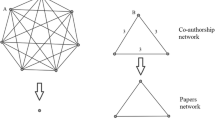Abstract
Scientific collaboration has become a major issue in science policy. The tremendous growth of collaboration among nations and research institutions witnessed during the last twenty years is a function of the internal dynamics of science as well as science policy initiatives. The need to survey and follow up the collaboration issue calls for statistical indicators sensitive enough to reveal the structure and change of collaborative networks. In this context, bibliometric analysis of co-authored scientific articles is one promising approach. This paper discusses the relationship between collaboration and co-authorship, the nature of bibliometric data, and exemplifies how they can be refined and used to analyse various aspects of collaboration.
Similar content being viewed by others
Notes and references
G. Melin, O, Persson, Hotel Cosmopolitan — A bibliometric study of collaboration at European universitiesPaper presented at the Fourth International Coference on Science and Technological Indicators: Performance at the National, Regional and Institutional Level” in Antwerpen, Oct 5–7, 1995.
J. Ziman,Prometheus Bound: Science in a Dynamic Steady State. Cambride University Press, Cambridge 1994.
J. S. Katz, B. R. Martin, What is Researh Collaboration?,Research Policy, (1996) (forthcoming).
M. A. Harsanyi, Multipel Authors, Multiple Problems — Bibliometrics and the Study of Scholarly Collaboration: A Literature Review”,LISR, 15(1993) 325–354
op. cit.
op. cit.
G. Salton, M. J. McGill,Introduction to Modern Information Retrieval, McGraw-Hill, London 1983.
T. Luukkonen, R. J. W. Tussen, O. Persson, G. Sivertsen, The Measurement of International Scientific Collaboration,Scientometrics, 28 (1993) 15–36.
op. cit., Scientometrics, 28 (1993) 15–36.
G. Melin, The Networking University,Scientometrics, (1996) (forthcoming).
A. Kaloudis, Communication Patterns and Productivity in a Norwegian R&D-sector,Paper presented at the Fourth International Conference on Science and Technological Indicators: Performance at the National, Regional and Institutional Level” in Antwerpen, Oct 5–7, 1995.
Å. E. Andersson, O. Persson, Networking Scientists,Annals of Regional Science, 27 (1993) 11–21.
T. Luukkonen, O. Persson, G. Sivertsen, Understanding patterns of international scientific collaboration,Science, Technology and Human Values, 17 (1992) 101–126.
Y. Okubo, J. F. Miguel, L. Frigoletto, J. C. Dore, Structure of International Collaboration in Science: Typology of Countries Through Multivariate Techniques Using a Link Indicator,Scientometrics, 25 (1992) 321–351.
M. Leclerc, J. Gagné, International Scientific Cooperation: The Continentalization of Science,Scientometrics, 31 (1994) 261–262.
J. S. Katz, Geographical Proximity and Scientific Collaboration, Scientometrics, 31 (1993) 31–34.
Author information
Authors and Affiliations
Rights and permissions
About this article
Cite this article
Melin, G., Persson, O. Studying research collaboration using co-authorships. Scientometrics 36, 363–377 (1996). https://doi.org/10.1007/BF02129600
Received:
Issue Date:
DOI: https://doi.org/10.1007/BF02129600




